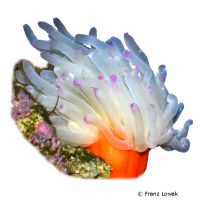Giant Golden Anemone (Condylactis gigantea)
| Giant Golden Anemone Condylactis gigantea | |
|---|---|
| Name | Giant Golden Anemone |
| Name Lat. | Condylactis gigantea |
| Synonym | Condylactis passiflora |
| Family | Sea Anemones |
| Family lat. | Actiniidae |
| Order | Sea Anemones |
| Order lat. | Actiniaria |
| Origin | Western Atlantic |
| Diet | Autotrophic, carnivore |
| pH | 8.1-8.4 |
| Hardness | 8-10 °KH |
| Lighting | High |
| Current | Moderate |
| Behavior | Semi-aggressive |
| Keeping | Individual, group |
| Care Level | Moderate |
| Life Span | N/A |
| Protection | No |
| Metric Units | |
| Size | 10-30 cm |
| Temperature | 24-26 °C |
| Salinity | 33-36 ‰ |
| Aquarium | 300 l |
| US Units | |
| Size | 4"-12" |
| Temperature | 75-79 °F |
| Salinity | 1.020-1.025 sg |
| Aquarium | 80 gal |
Distribution and habitat
Condylactis gigantea are widely distributed in the tropical western Atlantic, from the Bahamas through the Caribbean and Gulf of Mexico to Brazil's northern coast. They live solitary or in loose groups in lagoons and on inner reefs, where they usually attach themselves to crevices and holes in coral rock.
Maintenance
They should be positioned in a very bright spot among jagged rocks in a medium, alternating current by gently pressing them there for a short time. Mostly, however, it looks for its place itself
Only lime-rich, heavy metal-free substrates may be used as substrate. To ensure water quality, filters, skimmers and heaters are necessary, as well as pumps to simulate tides, swells and bottom currents. It is recommended that live stones be used to set up the aquarium. The bacteria living in the porous stones act as a biological filter. The lighting must correspond to the species-appropriate day-night rhythm of the animals
| Salinity: 33-36 ‰ | pH value: 8.1-8.4 |
| Carbonate hardness: 8-10 °KH | Nitrate content: 2-8 mg/l |
| calcium content: 420-450 mg/l | Nitrite content: 0.0-0.05 mg/l |
| Magnesium content: 1.250-1.350 mg/l | phosphate content: 0.01-0.1 mg/l |
Regular addition of trace elements, especially iodine, is recommended. For salinity, an average value should be aimed for, which may only vary slightly by +/- 0.5 ‰. Ammonia and ammonium must not be measurable. Special attention shall be paid to consistently good water quality and water values.
Diet
Zooxanthellae, which are unicellular symbiotic algae, live in their tissue and provide them with assimilation products of their photosynthesis (high light requirement). The zooxanthellae promote growth and provide additional food to the plankton and small particles collected from the water current. Besides the food that accumulates in the aquarium during fish feeding (smelt, mysis, krill, artemia, etc.), there is hardly any need for additional feeding. Regular and varied feeding promotes health and prevents deficiency symptoms.
Behaviour and compatibility
It is not colonized by anemonefish and only serves as a symbiotic anemone for the shrimp Thor ambionensis and Periclimenes brevicarpalis. Other animals that stick to its tentacles are devoured. A sufficiently large distance must be maintained to corals and other anemones to prevent them from becoming encrusted.
Reproduction and breeding
It is assumed that their reproduction is sexual via marine larval stages. But they can also reproduce by division, which is often observed in the aquarium.
Important
They come in different color forms, such as green, purple, brown, and white, and can have green, purple, or mangenta tentacle tips.
After being placed in the aquarium, they sometimes wander until they find a suitable place themselves. In doing so, they can endanger other anemones or corals with their nettles.
Healthy animals have a closed mouth disc, look "pumped up" and do not drift around.
They are very sensitive and can be easily injured when handled
The additional lighting with actinic light (short-wave violet-blue light) is very beneficial for their growth (zooxanthellae)
Newly introduced animals must be acclimated slowly to the water in the aquarium. If different species are kept together, make sure that fish and invertebrates match each other in terms of water quality and temperature requirements as well as their social behavior, and that the setup meets the ecological needs of all species kept together
Further literature can be found in your pet store.
References
Text: Werner Winter; Image: Franz Lowak
Source: ENGELMANN & LANGE (2011): Zootierhaltung - Tiere in menschlicher Obhut: Wirbellose, Verlag Harri Deutsch; BAENSCH & DEBELIUS (2006): Meerwasser Atlas Bd. 1, Mergus Verlag
